Twin Self-Supervised Learning Framework for Glaucoma Diagnosis Using Fundus Images
Abstract
1. Introduction
The Contribution of This Work
- Addressing the challenge of limited annotated fundus images: the work creates a twin model (semi-supervised and self-supervised) with a CAE and exemplar CNN method for glaucoma detection that uses both labeled and unlabeled fundus images and addresses the barrier of limited labeled fundus images.
- Generating pseudo-labels for unlabeled fundus images: to improvise the detection of glaucoma using unlabeled images, self-supervised learning (exemplar CNN) is used in the proposed method to generate pseudo-labels that learn the beneficial features and the inherent structure of the image better by itself, without a need for explicit labels or supervision.
- Exemplar CNN method trained for effective and enhanced feature learning: by focusing on curating different transformed patches, which contribute to the synthetic classes, the CNN is then trained to differentiate between the synthetic classes, allowing it to acquire distinguished characteristics from the unlabeled images leading to improved performance in glaucoma detection.
- Validation of effectiveness of the usage of the unlabeled fundus image: proposes a model that can effectively employ unlabeled images for training and further improve its performance by producing pseudo-labels. The model’s performance and learning improvement are verified with increased accuracy, sensitivity, etc., in glaucoma detection using unlabeled fundus images.
- Adaptability and robustness to changes in dataset size: performance analysis was carried out by varying the dataset size over small to large datasets to test the proposed model’s adaptability and requirements.
- Adaptability and robustness over varied datasets: the improvement in performance shows the adaptability and robustness of the proposed method by applying it to a variety of datasets’ fundus images.
2. Related Works
2.1. Supervised Learning
2.2. Semi-Supervised Learning
2.3. Pseudo-Label Generation
2.4. Motivations from the Related Work
3. Materials
4. Proposed Method
| Algorithm 1: Data Set Separation |
| Input: Fundus dataset , Output: —Labeled data, —Unlabeled data |
|
4.1. Self-Supervised Learning
4.2. Pseudo-Label Generation in the Proposed Method
4.2.1. Self-Supervision 1
Pretext Task—Exemplar CNN Feature Learning
| Algorithm 2: Pseudo-label generation |
| Input: Unlabeled fundus images , Output: Pseudo-labels |
|
Downstream Task—Glaucoma Detection
4.3. Glaucoma Detection with Expanded Fundus Dataset in the Proposed Method
4.3.1. Self-Supervision 2
Pretext Task—Reconstruction of Fundus Images
| Algorithm 3: Glaucoma detection with enhanced fundus dataset |
| Input: Enhanced fundus dataset , Output: Detection of glaucoma labels |
|
Downstream Task—Glaucoma Detection
5. Experimental Results and Discussion
5.1. Core Architecture Results for Glaucoma Detection
5.2. Performance of Vanilla AE with Pseudo-Labeled Fundus Images and Varying Dataset Size
5.3. Performance of CAE with Pseudo-Labeled Fundus Images and Varying Dataset Size
5.4. Performance of DAE with Pseudo-Labeled Fundus Images and Varying Dataset Size
5.5. Core Architecture vs. Proposed Method vs. Existing Approaches: Performance Analysis
6. Conclusions
Supplementary Materials
Author Contributions
Funding
Institutional Review Board Statement
Data Availability Statement
Conflicts of Interest
References
- Stein, J.D.; Khawaja, A.P.; Weizer, J.S. Glaucoma in Adults-Screening, Diagnosis, and Management: A Review. JAMA 2021, 325, 164–174. [Google Scholar] [CrossRef]
- Hagiwara, Y.; Koh, J.E.W.; Tan, J.H.; Bhandary, S.V.; Laude, A.; Ciaccio, E.J.; Tong, L.; Acharya, U.R. Computer-Aided Diagnosis of Glaucoma Using Fundus Images: A Review. Comput. Methods Programs Biomed. 2018, 165, 1–12. [Google Scholar] [CrossRef] [PubMed]
- Sengupta, S.; Singh, A.; Leopold, H.A.; Gulati, T.; Lakshminarayanan, V. Ophthalmic Diagnosis Using Deep Learning with Fundus Images—A Critical Review. Artif. Intell. Med. 2020, 102, 101758. [Google Scholar] [CrossRef] [PubMed]
- Bindu, A.; Thangavel, S.K.; Somasundaram, K.; Parthasaradhi, S.; Pulgurthi, R.G.; Dhar, M.Y. Beyond the Black Box: Explainable AI for Glaucoma Detection and Future Improvements. In Proceedings of the 2024 15th International Conference on Computing Communication and Networking Technologies, Kamand, India, 24–28 June 2024; pp. 1–9. [Google Scholar] [CrossRef]
- Rajanbabu, K.; Veetil, I.K.; Sowmya, V.; Gopalakrishnan, E.A.; Soman, K.P. Ensemble of Deep Transfer Learning Models for Parkinson’s Disease Classification. In Soft Computing and Signal Processing; Springer: Berlin/Heidelberg, Germany, 2022; pp. 135–143. [Google Scholar] [CrossRef]
- Thompson, A.C.; Jammal, A.A.; Medeiros, F.A. A Review of Deep Learning for Screening, Diagnosis, and Detection of Glaucoma Progression. Transl. Vis. Sci. Technol. 2020, 9, 42. [Google Scholar] [CrossRef] [PubMed]
- Zedan, M.J.M.; Zulkifley, M.A.; Ibrahim, A.A.; Moubark, A.M.; Kamari, N.A.M.; Abdani, S.R. Automated Glaucoma Screening and Diagnosis Based on Retinal Fundus Images Using Deep Learning Approaches: A Comprehensive Review. Diagnostics 2023, 13, 2180. [Google Scholar] [CrossRef]
- Zhou, W.; Gao, Y.; Ji, J.; Li, S.; Yi, Y. Unsupervised Anomaly Detection for Glaucoma Diagnosis. Wirel. Commun. Mob. Comput. 2021, 2021, 5978495. [Google Scholar] [CrossRef]
- Raza, K.; Singh, N.K. A Tour of Unsupervised Deep Learning for Medical Image Analysis. Curr. Med. Imaging 2021, 17, 1059–1077. [Google Scholar] [CrossRef]
- Mo, J.; Gan, Y.; Yuan, H. Weighted Pseudo Labeled Data and Mutual Learning for Semi-Supervised Classification. IEEE Access 2021, 9, 36522–36534. [Google Scholar] [CrossRef]
- Seydgar, M.; Rahnamayan, S.; Ghamisi, P.; Bidgoli, A.A. Semisupervised Hyperspectral Image Classification Using a Probabilistic Pseudo-Label Generation Framework. IEEE Trans. Geosci. Remote Sens. 2022, 60, 5535218. [Google Scholar] [CrossRef]
- Al Ghamdi, M.; Li, M.; Abdel-Mottaleb, M.; Shousha, M.A. Semi-Supervised Transfer Learning for Convolutional Neural Networks for Glaucoma Detection. In Proceedings of the ICASSP, IEEE International Conference on Acoustics, Speech and Signal Processing—Proceedings 2019, Brighton, UK, 12–17 May 2019; pp. 3812–3816. [Google Scholar] [CrossRef]
- Cui, Y.; Ji, X.; Xu, K.; Wang, L. A Double-Strategy-Check Active Learning Algorithm for Hyperspectral Image Classification. Photogramm. Eng. Remote Sens. 2019, 85, 841–851. [Google Scholar] [CrossRef]
- Sun, B.; Kang, X.; Li, S.; Benediktsson, J.A. Random-Walker-Based Collaborative Learning for Hyperspectral Image Classification. IEEE Trans. Geosci. Remote Sens. 2017, 55, 212–222. [Google Scholar] [CrossRef]
- Zhang, Y.; Cao, G.; Li, X.; Wang, B.; Fu, P. Active Semi-Supervised Random Forest for Hyperspectral Image Classification. Remote Sens. 2019, 11, 2974. [Google Scholar] [CrossRef]
- Xu, X.; Liao, J.; Cai, L.; Nguyen, M.C.; Lu, K.; Zhang, W.; Yazici, Y.; Foo, C.S. Revisiting Pretraining for Semi-Supervised Learning in the Low-Label Regime. Neurocomputing 2024, 565, 126971. [Google Scholar] [CrossRef]
- Krishnan, R.; Rajpurkar, P.; Topol, E.J. Self-Supervised Learning in Medicine and Healthcare. Nat. Biomed. Eng. 2022, 6, 1346–1352. [Google Scholar] [CrossRef]
- Yang, X.; Song, Z.; King, I.; Xu, Z. A Survey on Deep Semi-Supervised Learning. IEEE Trans. Knowl. Data Eng. 2023, 35, 8934–8954. [Google Scholar] [CrossRef]
- Mao, J.; Yin, X.; Zhang, G.; Chen, B.; Chang, Y.; Chen, W.; Yu, J.; Wang, Y. Pseudo-Labeling Generative Adversarial Networks for Medical Image Classification. Comput. Biol. Med. 2022, 147, 105729. [Google Scholar] [CrossRef]
- Shurrab, S.; Duwairi, R. Self-Supervised Learning Methods and Applications in Medical Imaging Analysis: A Survey. PeerJ Comput. Sci. 2022, 8, e1045. [Google Scholar] [CrossRef]
- Krishnan, S.; Amudha, J.; Tejwani, S. Gaze Fusion-Deep Neural Network Model for Glaucoma Detection. Commun. Comput. Inf. Sci. 2021, 1366, 42–53. [Google Scholar] [CrossRef]
- Gómez-Valverde, J.J.; Antón, A.; Fatti, G.; Liefers, B.; Herranz, A.; Santos, A.; Sánchez, C.I.; Ledesma-Carbayo, M.J. Automatic Glaucoma Classification Using Color Fundus Images Based on Convolutional Neural Networks and Transfer Learning. Biomed. Opt. Express 2019, 10, 892. [Google Scholar] [CrossRef]
- Sushil, M.; Suguna, G.; Lavanya, R.; Nirmala Devi, M. Performance Comparison of Pre-Trained Deep Neural Networks for Automated Glaucoma Detection. In Lecture Notes in Computational Vision and Biomechanics; Springer: Berlin/Heidelberg, Germany, 2019; Volume 30, pp. 631–637. [Google Scholar] [CrossRef]
- Latif, J.; Tu, S.; Xiao, C.; Rehman, S.U.; Sadiq, M.; Farhan, M. Digital Forensics Use Case for Glaucoma Detection Using Transfer Learning Based on Deep Convolutional Neural Networks. Secur. Commun. Netw. 2021, 2021, 4494447. [Google Scholar] [CrossRef]
- Suguna, G.; Lavanya, R. Performance Assessment of EyeNet Model in Glaucoma Diagnosis. Pattern Recognit. Image Anal. 2021, 31, 334–344. [Google Scholar] [CrossRef]
- Singh, L.K.; Pooja; Garg, H.; Khanna, M. Deep Learning System Applicability for Rapid Glaucoma Prediction from Fundus Images across Various Data Sets. Evol. Syst. 2022, 13, 807–836. [Google Scholar] [CrossRef]
- Shoukat, A.; Akbar, S.; Hassan, S.A.; Iqbal, S.; Mehmood, A.; Ilyas, Q.M. Automatic Diagnosis of Glaucoma from Retinal Images Using Deep Learning Approach. Diagnostics 2023, 13, 1738. [Google Scholar] [CrossRef] [PubMed]
- Bechar, M.E.A.; Settouti, N.; Barra, V.; Chikh, M.A. Semi-Supervised Superpixel Classification for Medical Images Segmentation. Multidimens. Syst. Signal Process 2018, 29, 979–998. [Google Scholar] [CrossRef]
- Pal, A.; Moorthy, M.R.; Shahina, A. G-Eyenet: A Convolutional Autoencoding Classifier Framework for the Detection of Glaucoma from Retinal Fundus Images. In Proceedings of the 2018 25th International Conference on Image Processing, ICIP, Athens, Greece, 7–10 October 2018; pp. 2775–2779. [Google Scholar] [CrossRef]
- Raghavendra, U.; Gudigar, A.; Bhandary, S.V.; Rao, T.N.; Ciaccio, E.J.; Acharya, U.R. A Two Layer Sparse Autoencoder for Glaucoma Identification with Fundus Images. J. Med. Syst. 2019, 43, 299. [Google Scholar] [CrossRef]
- Diaz-Pinto, A.; Colomer, A.; Naranjo, V.; Morales, S.; Xu, Y.; Frangi, A.F. Retinal Image Synthesis and Semi-Supervised Learning for Glaucoma Assessment. IEEE Trans. Med. Imaging 2019, 38, 2211–2218. [Google Scholar] [CrossRef]
- Alghamdi, M.; Abdel-Mottaleb, M. A Comparative Study of Deep Learning Models for Diagnosing Glaucoma from Fundus Images. IEEE Access 2021, 9, 23894–23906. [Google Scholar] [CrossRef]
- Fan, R.; Bowd, C.; Brye, N.; Christopher, M.; Weinreb, R.N.; Kriegman, D.J.; Zangwill, L.M. One-Vote Veto: Semi-Supervised Learning for Low-Shot Glaucoma Diagnosis. IEEE Trans. Med. Imaging 2023, 42, 3764–3778. [Google Scholar] [CrossRef]
- Camara, J.; Rezende, R.; Pires, I.M.; Cunha, A. Retinal Glaucoma Public Datasets: What Do We Have and What Is Missing? J. Clin. Med. 2022, 11, 3850. [Google Scholar] [CrossRef]
- Sivaswamy, J.; Krishnadas, S.R.; Joshi, G.D.; Ujjwal, M.J.; Tabish, S. Drishti-GS: Retinal Image Dataset for Optic Nerve Head(ONH) Segmentation. In Proceedings of the 2014 IEEE 11th International Symposium on Biomedical Imaging, ISBI 2014, Beijing, China, 29 April–2 May 2014; pp. 53–56. [Google Scholar] [CrossRef]
- Zhang, Z.; Yin, F.S.; Liu, J.; Wong, W.K.; Tan, N.M.; Lee, B.H.; Cheng, J.; Wong, T.Y. ORIGA-Light: An Online Retinal Fundus Image Database for Glaucoma Analysis and Research. In Proceedings of the 2010 Annual International Conference of the IEEE Engineering in Medicine and Biology 2010, Buenos Aires, Argentina, 31 August–4 September 2010; pp. 3065–3068. [Google Scholar] [CrossRef]
- Budai, A.; Bock, R.; Maier, A.; Hornegger, J.; Michelson, G. Robust Vessel Segmentation in Fundus Images. Int. J. Biomed. Imaging 2013, 2013, 154860. [Google Scholar] [CrossRef]
- De Vente, C.; Vermeer, K.A.; Jaccard, N.; Wang, H.; Sun, H.; Khader, F.; Truhn, D.; Aimyshev, T.; Zhanibekuly, Y.; Le, T.D.; et al. AIROGS: Artificial Intelligence for RObust Glaucoma Screening Challenge. IEEE Trans. Med. Imaging 2023, 43, 542–557. [Google Scholar] [CrossRef]
- Jin, K.; Huang, X.; Zhou, J.; Li, Y.; Yan, Y.; Sun, Y.; Zhang, Q.; Wang, Y.; Ye, J. FIVES: A Fundus Image Dataset for Artificial Intelligence Based Vessel Segmentation. Sci. Data 2022, 9, 475. [Google Scholar] [CrossRef]
- Jin, K.; Gao, Z.; Jiang, X.; Wang, Y.; Ma, X.; Li, Y.; Ye, J. MSHF: A Multi-Source Heterogeneous Fundus (MSHF) Dataset for Image Quality Assessment. Sci. Data 2023, 10, 286. [Google Scholar] [CrossRef] [PubMed]
- Orlando, J.I.; Barbosa Breda, J.; van Keer, K.; Blaschko, M.B.; Blanco, P.J.; Bulant, C.A. Towards a Glaucoma Risk Index Based on Simulated Hemodynamics from Fundus Images. In Lecture Notes in Computer Science (Including Subseries Lecture Notes in Artificial Intelligence and Lecture Notes in Bioinformatics); Springer: Berlin/Heidelberg, Germany, 2018; Volume 11071, pp. 65–73. [Google Scholar] [CrossRef]
- Bajwa, M.N.; Singh, G.A.P.; Neumeier, W.; Malik, M.I.; Dengel, A.; Ahmed, S. G1020: A Benchmark Retinal Fundus Image Dataset for Computer-Aided Glaucoma Detection. In Proceedings of the International Joint Conference on Neural Networks 2020, Glasgow, UK, 19–24 July 2020. [Google Scholar] [CrossRef]
- Hassan, T.; Akram, M.U.; Nazir, M.N. A Composite Retinal Fundus and OCT Dataset with Detailed Clinical Markings of Retinal Layers and Retinal Lesions to Grade Macular and Glaucomatous Disorders. In Proceedings of the 2022 2nd International Conference on Digital Futures and Transformative Technologies (ICoDT2), Rawalpindi, Pakistan, 24–26 May 2022; Volume 4. [Google Scholar] [CrossRef]
- Chen, M.; Shi, X.; Zhang, Y.; Wu, D.; Guizani, M. Deep Feature Learning for Medical Image Analysis with Convolutional Autoencoder Neural Network. IEEE Trans. Big Data 2017, 7, 750–758. [Google Scholar] [CrossRef]
- Keerthana, D.; Venugopal, V.; Nath, M.K.; Mishra, M. Hybrid Convolutional Neural Networks with SVM Classifier for Classification of Skin Cancer. Biomed. Eng. Adv. 2023, 5, 100069. [Google Scholar] [CrossRef]
- Wu, H.; Huang, Q.; Wang, D.; Gao, L. A CNN-SVM combined model for pattern recognition of knee motion using mechanomyography signals. J. Electromyogr. Kinesiol. 2018, 42, 136–142. [Google Scholar] [CrossRef]
- Dosovitskiy, A.; Fischer, P.; Springenberg, J.T.; Riedmiller, M.; Brox, T. Discriminative Unsupervised Feature Learning with Exemplar Convolutional Neural Networks. IEEE Trans. Pattern Anal. Mach. Intell. 2016, 38, 1734–1747. [Google Scholar] [CrossRef]
- Santos, M.S.; Soares, J.P.; Abreu, P.H.; Araujo, H.; Santos, J. Cross-validation for imbalanced datasets: Avoiding overoptimistic and overfitting approaches [Research Frontier]. IEEE Comput. Intell. Mag. 2018, 13, 59–76. [Google Scholar] [CrossRef]
- Kovalyk, O.; Morales-Sánchez, J.; Verdú-Monedero, R.; Sellés-Navarro, I.; Palazón-Cabanes, A.; Sancho-Gómez, J.L. PAPILA: Dataset with fundus images and clinical data of both eyes of the same patient for glaucoma assessment. Sci. Data 2022, 9, 291. [Google Scholar] [CrossRef]
- Remyes, D.; Nasef, D.; Remyes, S.; Tawfellos, J.; Sher, M.; Nasef, D.; Toma, M. Clinical Applicability and Cross-Dataset Validation of Machine Learning Models for Binary Glaucoma Detection. Information 2025, 16, 432. [Google Scholar] [CrossRef]
- Chowdhury, R.P.; Karkera, N.S. Early Glaucoma Detection using Deep Learning with Multiple Datasets of Fundus Images. arXiv 2025, arXiv:2506.21770. [Google Scholar] [CrossRef]

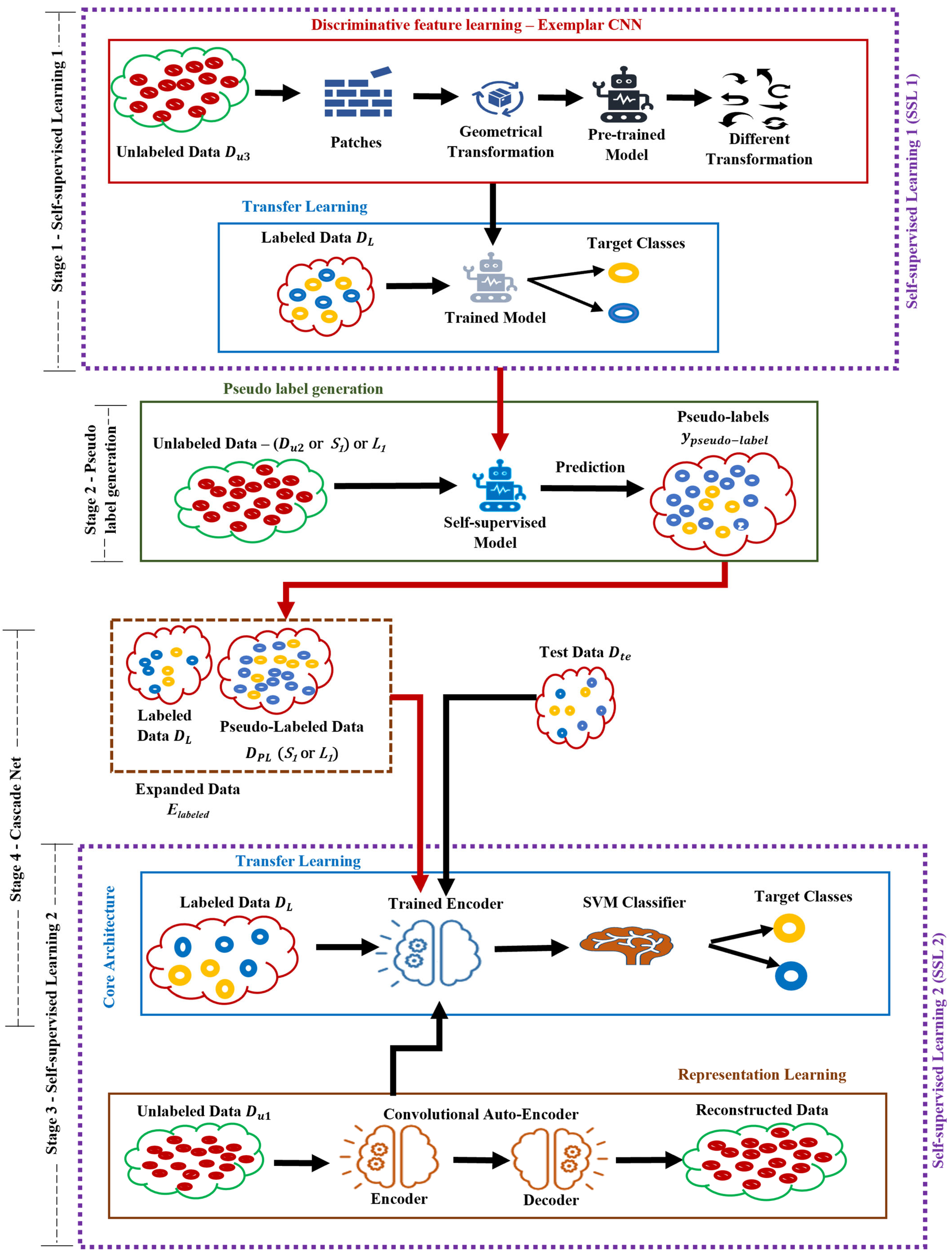
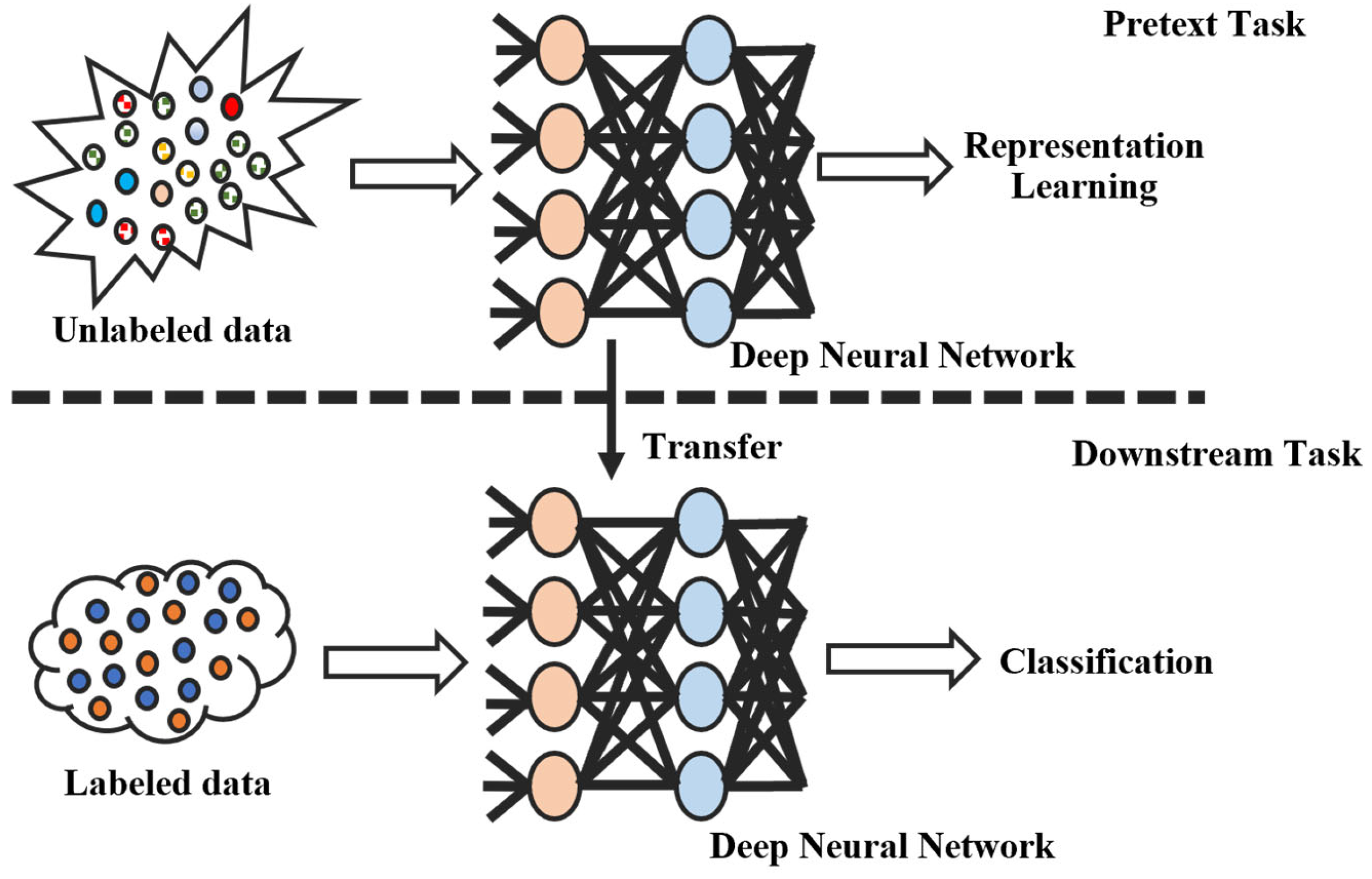
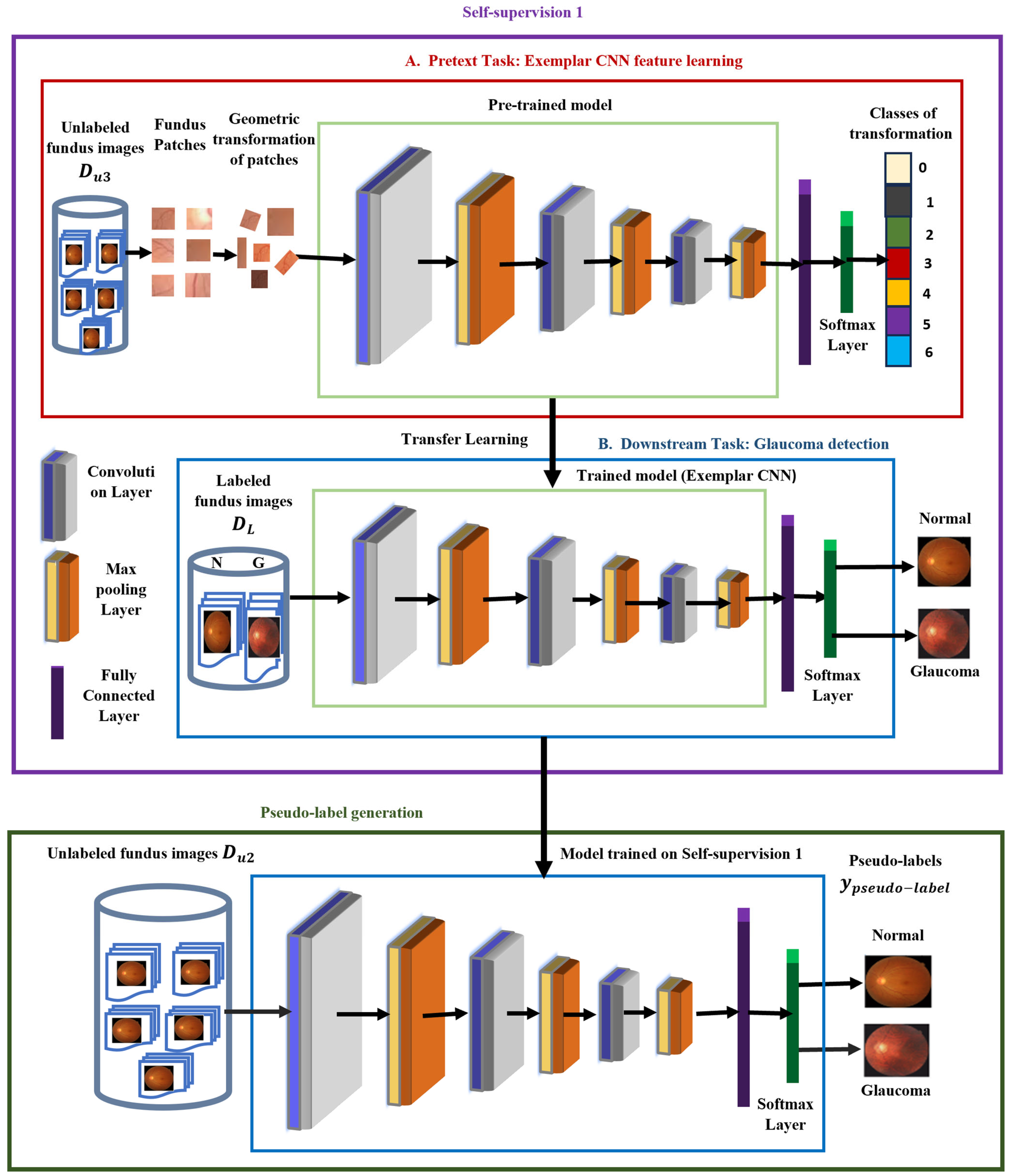
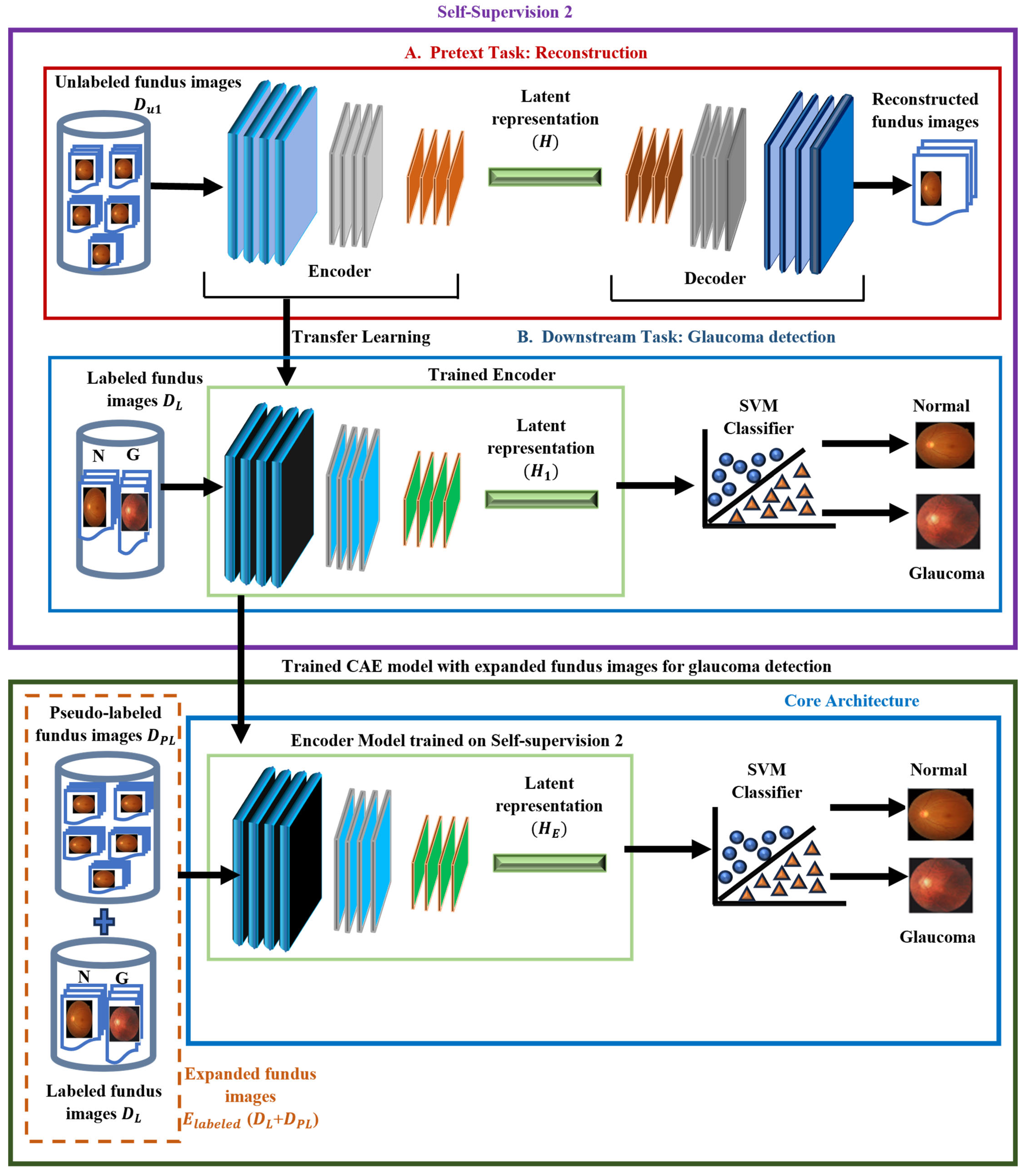
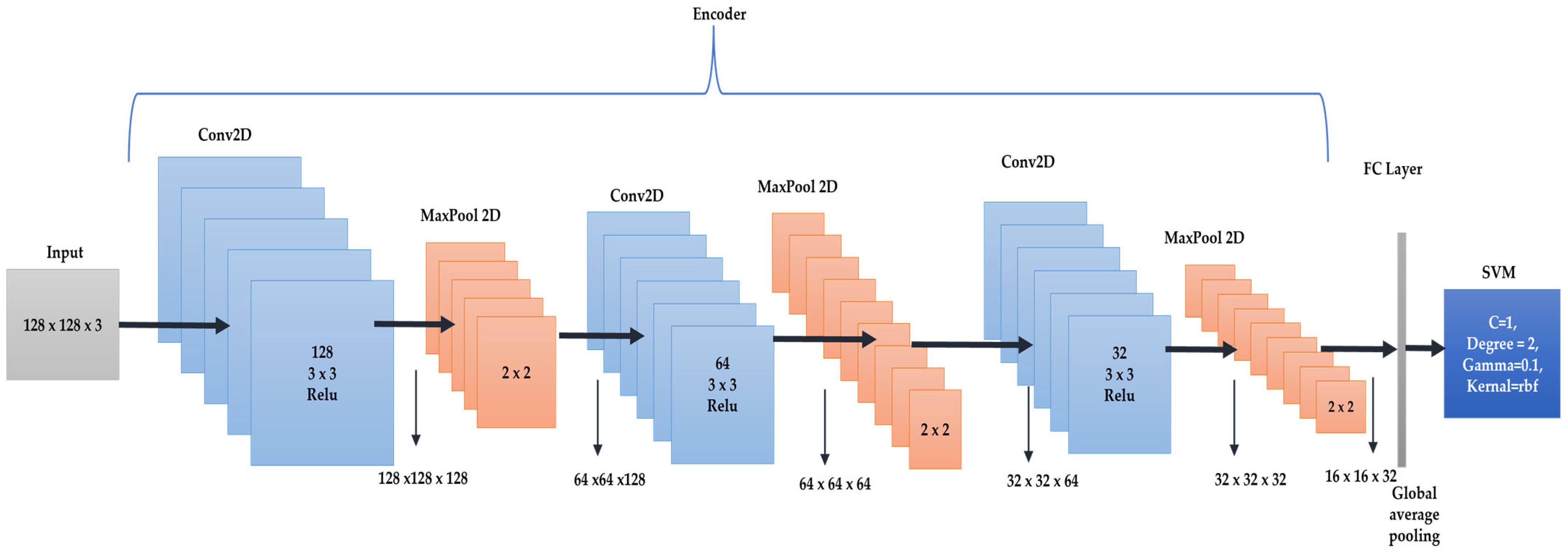
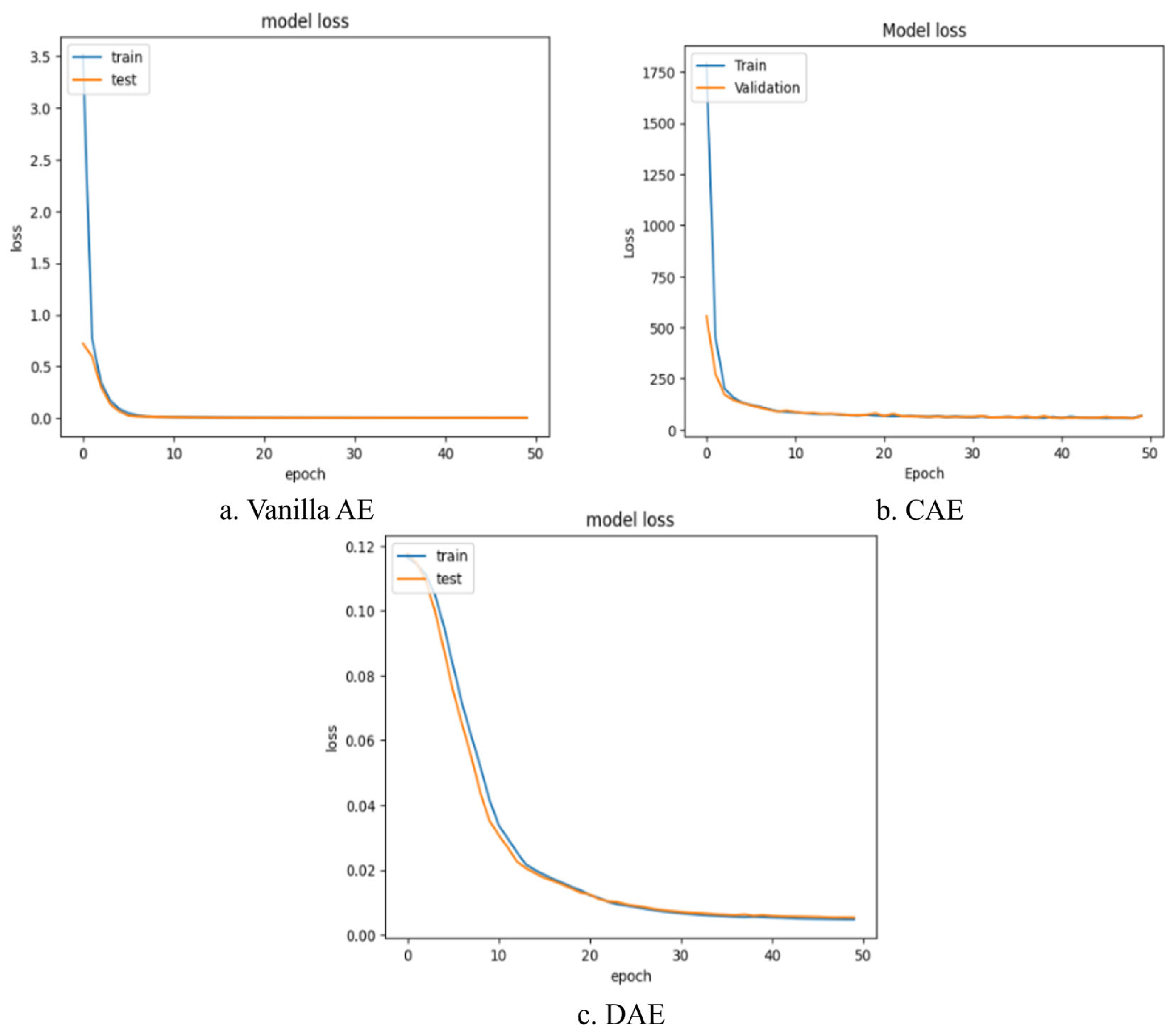
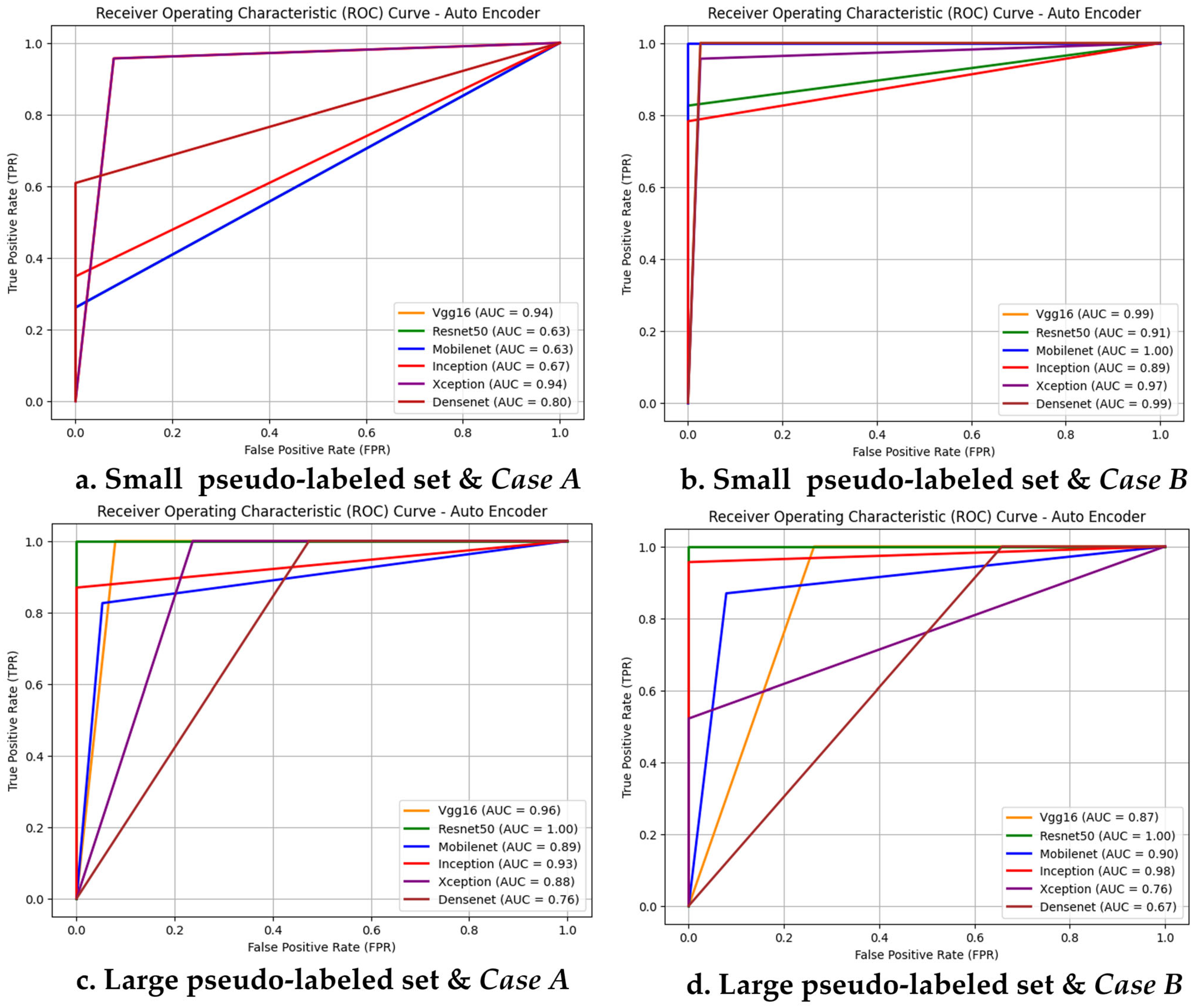
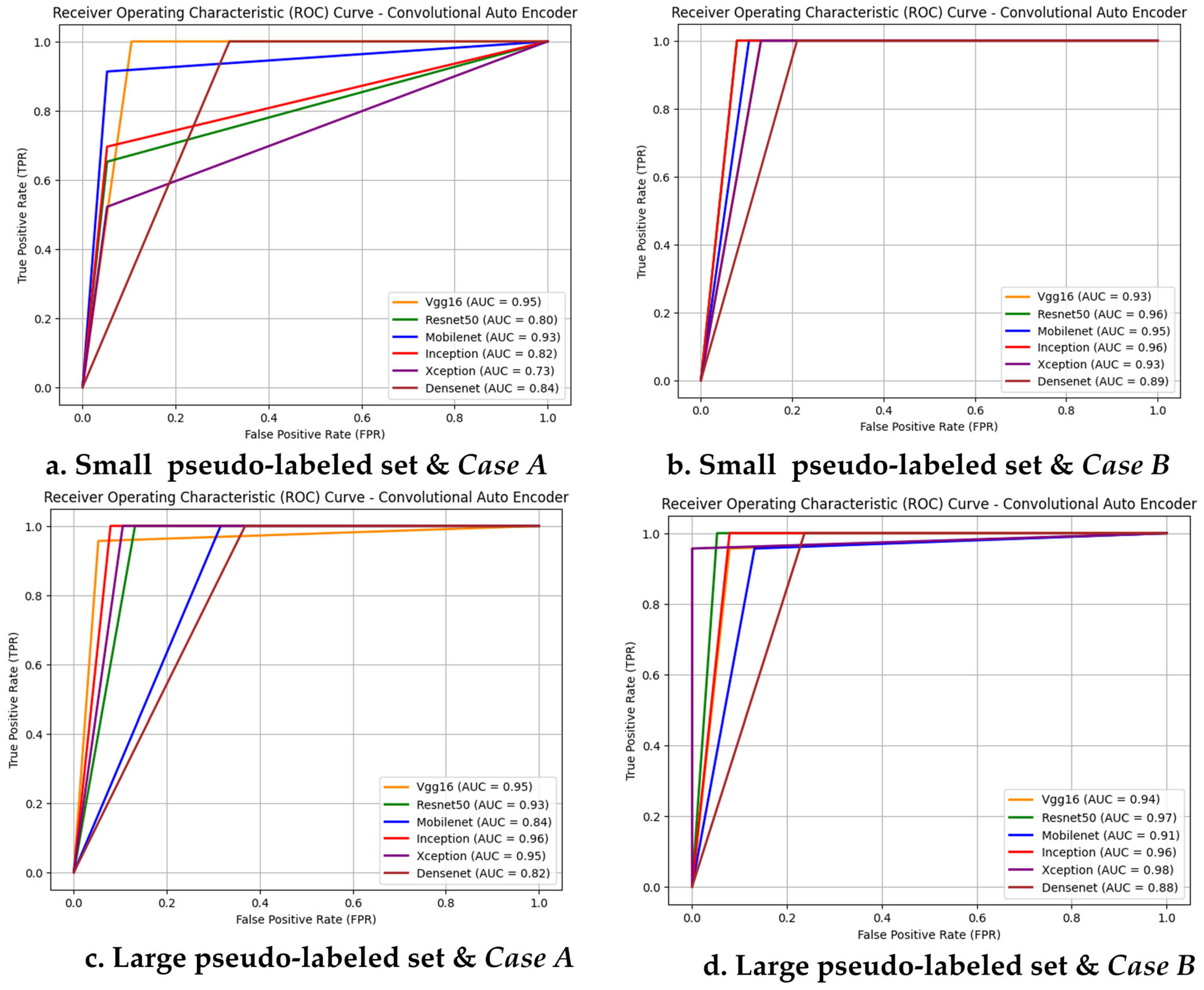
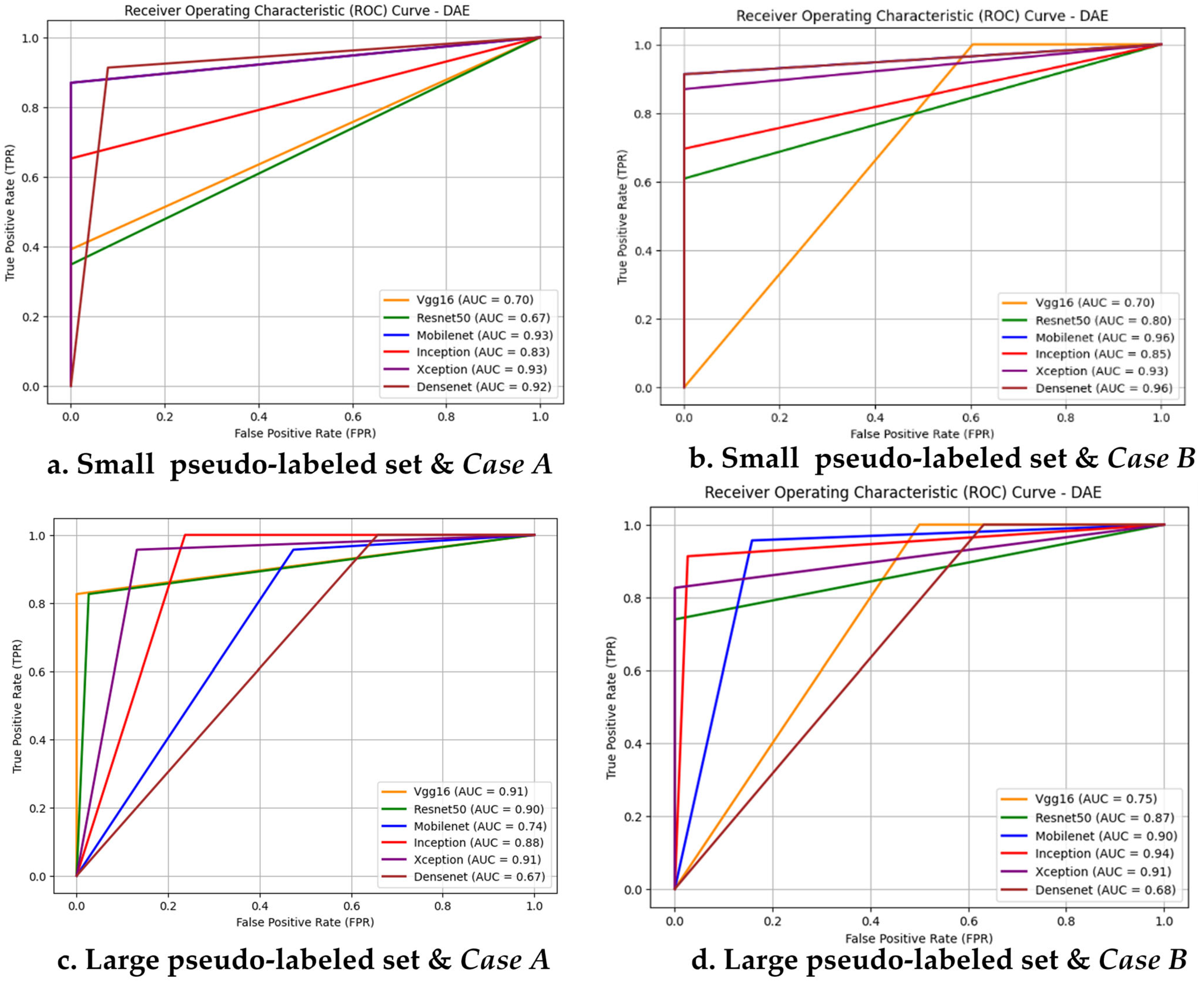

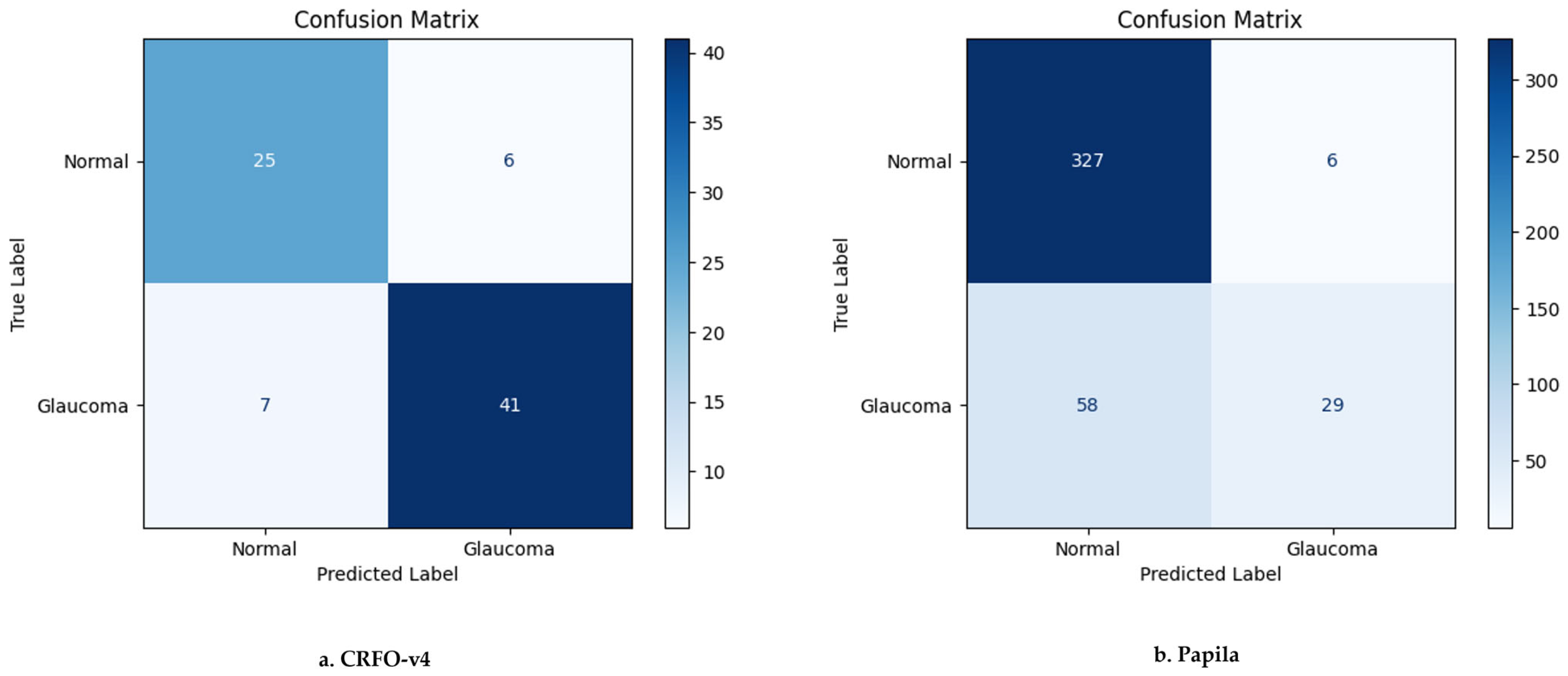
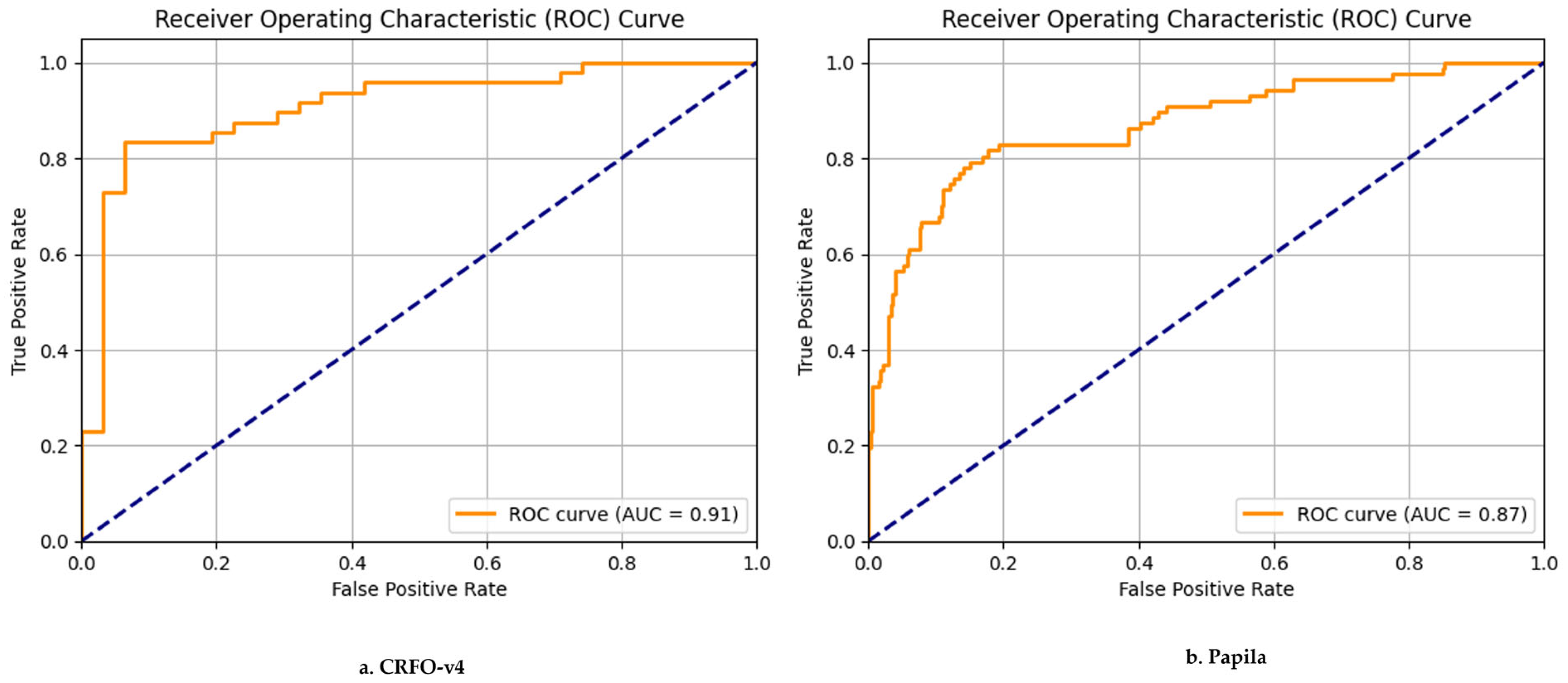
| Model | Database | No. of Images | Method | |
|---|---|---|---|---|
| N † | G † | |||
| VGG19 [22] | ESPERANZA | 1333 | 113 | Transfer learning |
| RIM-ONE r1 | 118 | 40 | ||
| RIM-ONE r2 | 255 | 200 | ||
| RIM-ONE r3 | 85 | 74 | ||
| Drishti-GS | 31 | 70 | ||
| VGG16 [23] | HRF | 15 | 15 | Fine-tuning |
| Inception-v3 [24] | Private | 1184 | 518 | Transfer learning |
| EyeNet [25] | RIM-ONE r2 | 255 | 200 | Transfer learning |
| Inception-ResNet-V2 [26] | ORIGA | 482 | 168 | Transfer learning and Fine-tuning |
| ACRIMA | 309 | 396 | ||
| HRF | 15 | 15 | ||
| Drishti-GS | 31 | 70 | ||
| Private | 20 | 13 | ||
| ResNet-50 [27] | G1020 | 724 | 296 | Data augmentation and Transfer learning |
| Drishti-GS | 31 | 70 | ||
| ORIGA | 482 | 168 | ||
| RIM-ONE | 118 | 41 | ||
| Model | Database | No. of Images (Unlabeled) | No. of Images (Labeled) | Method | |
|---|---|---|---|---|---|
| N † | G † | ||||
| Super-pixel architecture [28] | RIM-ONE r3 | - | 85 | 74 | Co-forest algorithm |
| Multi model Network G-EyeNet [29] | HRF | - | 15 | 15 | Preprocessing and encoder-decoder CNN training |
| Drishti-GS | 31 | 70 | |||
| RIM-ONE v3 | 85 | 74 | |||
| DRIONS-DB | 50 | 60 | |||
| Cascaded sparse auto-encoder [30] | Private | - | 294 | 418 | Feature extraction with Machine Learning (ML) classification |
| GAN [31] | ORIGA | 482 | 168 | Image synthesizing and Feature Extractor | |
| Drishti-GS | 31 | 70 | |||
| RIM-ONE | 261 | 194 | |||
| sjchoi86-HRF | 300 | 101 | |||
| HRF | 18 | 27 | |||
| ACRIMA | 309 | 396 | |||
| Collection of 9 databases | 84,569 | - | - | ||
| Model | Database | No. of Images (Unlabeled) | No. of Images (Labeled) | Method | |
|---|---|---|---|---|---|
| N † | G † | ||||
| SSCNN-DAE [32] | RIM-ONE | 255 | 200 | Unsupervised learning and Transfer learning | |
| RIGA | 750 | ||||
| Siamese network [33] | ACRIMA | 309 | 396 | Multi-Task Siamese Network (MTSN) + One Vote Veto (OVV) | |
| LAG | 3143 | 1711 | |||
| OHTS | 71,176 | 3502 | |||
| DIGS/ADAGES | 5184 | 4289 | |||
| Ref | Dataset | N † | G † | Total |
|---|---|---|---|---|
| [35] | Drishti-GS | 31 | 70 | 101 |
| [36] | ORIGA | 482 | 168 | 650 |
| Total | 513 | 238 | 751 |
| Ref | Dataset | N † | G † | Total |
|---|---|---|---|---|
| [37] | HRF | 15 | 15 | 30 |
| [38] | EyePACS-AIROGS | 3270 | 3270 | 6540 |
| [39] | FIVES | 200 | 200 | 400 |
| [40] | MSHF | 26 | 52 | 78 |
| [41] | LES-AV | 11 | 11 | 22 |
| [42] | G1020 | 724 | 296 | 1020 |
| [43] | CRFO-v4 | 31 | 48 | 79 |
| Total | 4277 | 3892 | 8169 |
| Model | Pre-Trained Model | Small Pseudo-Labeled Set | Large Pseudo-Labeled Set | ||||||
|---|---|---|---|---|---|---|---|---|---|
| Hyperparameters | Hyperparameters | ||||||||
| C | Degree | Gamma | Kernel | C | Degree | Gamma | Kernel | ||
| Vanilla AE | VGG16 | 1 | 2 | 0.1 | rbf | 0.1 | 8 | 0.001 | rbf |
| ResNet-50 | 0.1 | 7 | 0.01 | 0.01 | 7 | 0.002 | linear | ||
| MobileNet | 0.1 | 2 | 0.1 | 1 | 2 | 0.1 | rbf | ||
| Inception-v2 | 0.1 | 8 | 0.01 | 1 | 8 | 0.001 | |||
| Xception-v3 | 0.1 | 2 | 0.01 | 0.1 | 2 | 0.1 | |||
| DenseNet101 | 1 | 2 | 0.001 | 1 | 2 | 0.1 | |||
| CAE | VGG16 | 0.1 | 8 | 0.001 | rbf | 1 | 2 | 0.1 | rbf |
| ResNet-50 | 0.1 | 7 | 0.002 | 0.1 | 7 | 0.01 | |||
| MobileNet | 1 | 2 | 0.1 | 0.1 | 2 | 0.1 | |||
| Inception-v2 | 0.1 | 8 | 0.001 | 0.1 | 8 | 0.01 | |||
| Xception-v3 | 1 | 2 | 0.1 | 0.1 | 2 | 0.01 | |||
| DenseNet101 | 1 | 2 | 0.1 | 1 | 2 | 0.001 | |||
| DAE | VGG16 | 1 | 2 | 0.01 | rbf | 1 | 2 | 0.01 | rbf |
| ResNet-50 | 1 | 7 | 0.01 | 1 | 7 | 0.01 | |||
| MobileNet | 0.1 | 2 | 0.001 | 0.1 | 2 | 0.001 | |||
| Inception-v2 | 0.1 | 8 | 0.001 | 0.1 | 8 | 0.001 | |||
| Xception-v3 | 0.1 | 2 | 0.001 | 0.1 | 2 | 0.0001 | |||
| DenseNet101 | 0.1 | 7 | 0.001 | 0.1 | 7 | 0.001 | |||
| Auto-Encoders in the Core Architecture | Performance Metrics | ||||||
|---|---|---|---|---|---|---|---|
| Acc (%) | F1 (%) | Prec (%) | Recall (%) | Sen (%) | Spec (%) | AUC | |
| Vanilla AE | 80 | 84 | 80 | 83 | 90 | 71 | 0.84 |
| CAE | 85 | 88 | 85 | 86 | 71 | 100 | 0.88 |
| DAE | 93 | 95 | 93 | 93 | 85 | 100 | 0.94 |
| Models | Case A | Case B | ||||||||||||
|---|---|---|---|---|---|---|---|---|---|---|---|---|---|---|
| Acc (%) | F1 (%) | Prec (%) | Recall (%) | Sen (%) | Spec (%) | AUC | Acc (%) | F1 (%) | Prec (%) | Recall (%) | Sen (%) | Spec (%) | AUC | |
| VGG16 | 93 | 93 | 93 | 94 | 96 | 92 | 0.94 | 98 | 98 | 98 | 99 | 100 | 97 | 0.99 |
| ResNet-50 | 72 | 62 | 85 | 63 | 26 | 100 | 0.63 | 93 | 93 | 95 | 91 | 83 | 100 | 0.91 |
| MobileNet | 72 | 62 | 85 | 63 | 26 | 100 | 0.63 | 100 | 100 | 100 | 100 | 100 | 100 | 1.00 |
| Inception-v2 | 75 | 68 | 86 | 67 | 35 | 100 | 0.67 | 92 | 91 | 94 | 89 | 78 | 100 | 0.89 |
| Xception-v3 | 93 | 93 | 93 | 94 | 96 | 92 | 0.94 | 97 | 97 | 97 | 97 | 96 | 97 | 0.97 |
| DenseNet-101 | 85 | 83 | 90 | 80 | 61 | 100 | 0.80 | 98 | 98 | 98 | 99 | 100 | 97 | 0.99 |
| Models | Case A | Case B | ||||||||||||
|---|---|---|---|---|---|---|---|---|---|---|---|---|---|---|
| Acc (%) | F1 (%) | Prec (%) | Recall (%) | Sen (%) | Spec (%) | AUC | Acc (%) | F1 (%) | Prec (%) | Recall (%) | Sen (%) | Spec (%) | AUC | |
| VGG16 | 95 | 95 | 94 | 96 | 100 | 92 | 0.96 | 83 | 83 | 85 | 85 | 100 | 74 | 0.87 |
| ResNet-50 | 100 | 100 | 100 | 100 | 100 | 100 | 1.00 | 100 | 100 | 100 | 100 | 100 | 100 | 1.00 |
| MobileNet | 90 | 89 | 90 | 89 | 83 | 95 | 0.89 | 90 | 90 | 90 | 90 | 87 | 92 | 0.90 |
| Inception-v2 | 95 | 95 | 96 | 93 | 87 | 100 | 0.93 | 98 | 98 | 99 | 98 | 96 | 100 | 0.98 |
| Xception-v3 | 85 | 85 | 86 | 88 | 80 | 76 | 0.88 | 82 | 78 | 89 | 76 | 52 | 100 | 0.76 |
| DenseNet-101 | 70 | 70 | 78 | 76 | 100 | 53 | 0.76 | 59 | 59 | 74 | 67 | 100 | 34 | 0.67 |
| Model | Case A | Case B | ||||||||||||
|---|---|---|---|---|---|---|---|---|---|---|---|---|---|---|
| Acc (%) | F1 (%) | Prec (%) | Recall (%) | Sen (%) | Spec (%) | AUC | Acc (%) | F1 (%) | Prec (%) | Recall (%) | Sen (%) | Spec (%) | AUC | |
| VGG16 | 93 | 93 | 93 | 95 | 100 | 89 | 0.95 | 92 | 92 | 91 | 93 | 100 | 87 | 0.93 |
| ResNet-50 | 83 | 81 | 85 | 80 | 65 | 95 | 0.80 | 95 | 95 | 94 | 96 | 100 | 92 | 0.96 |
| MobileNet | 93 | 93 | 93 | 93 | 91 | 95 | 0.93 | 93 | 93 | 93 | 95 | 100 | 89 | 0.95 |
| Inception-v2 | 85 | 83 | 86 | 82 | 70 | 95 | 0.82 | 95 | 95 | 94 | 96 | 100 | 92 | 0.96 |
| Xception-v3 | 78 | 75 | 81 | 73 | 52 | 95 | 0.73 | 92 | 92 | 91 | 93 | 100 | 87 | 0.93 |
| DenseNet-101 | 80 | 80 | 83 | 84 | 100 | 68 | 0.84 | 87 | 87 | 87 | 89 | 100 | 79 | 0.89 |
| Model | Case A | Case B | ||||||||||||
|---|---|---|---|---|---|---|---|---|---|---|---|---|---|---|
| Acc (%) | F1 (%) | Prec (%) | Recall (%) | Sen (%) | Spec (%) | AUC | Acc (%) | F1 (%) | Prec (%) | Recall (%) | Sen (%) | Spec (%) | AUC | |
| VGG16 | 95 | 95 | 94 | 95 | 96 | 95 | 0.95 | 93 | 93 | 93 | 94 | 96 | 92 | 0.94 |
| ResNet-50 | 91 | 92 | 91 | 93 | 100 | 87 | 0.93 | 97 | 97 | 96 | 97 | 100 | 95 | 0.97 |
| MobileNet | 80 | 80 | 83 | 84 | 100 | 68 | 0.84 | 90 | 90 | 89 | 91 | 96 | 87 | 0.91 |
| Inception-v2 | 95 | 95 | 94 | 96 | 100 | 92 | 0.96 | 95 | 95 | 94 | 96 | 100 | 92 | 0.96 |
| Xception-v3 | 93 | 93 | 93 | 95 | 100 | 89 | 0.95 | 98 | 98 | 99 | 98 | 96 | 100 | 0.98 |
| DenseNet101 | 77 | 77 | 81 | 82 | 100 | 63 | 0.82 | 85 | 85 | 86 | 88 | 100 | 76 | 0.88 |
| Model | Case A | Case B | ||||||||||||
|---|---|---|---|---|---|---|---|---|---|---|---|---|---|---|
| Acc (%) | F1 (%) | Prec (%) | Recall (%) | Sen (%) | Spec (%) | AUC | Acc (%) | F1 (%) | Prec (%) | Recall (%) | Sen (%) | Spec (%) | AUC | |
| VGG16 | 77 | 70 | 87 | 70 | 39 | 100 | 0.70 | 62 | 62 | 75 | 70 | 100 | 39 | 0.70 |
| ResNet-50 | 75 | 68 | 86 | 67 | 35 | 67 | 0.67 | 85 | 83 | 90 | 90 | 61 | 100 | 0.80 |
| MobileNet | 95 | 95 | 96 | 93 | 87 | 93 | 0.93 | 97 | 96 | 97 | 96 | 91 | 100 | 0.96 |
| Inception-v2 | 87 | 85 | 91 | 83 | 65 | 83 | 0.83 | 89 | 87 | 92 | 85 | 70 | 100 | 0.85 |
| Xception-v3 | 95 | 95 | 96 | 93 | 87 | 93 | 0.93 | 95 | 95 | 96 | 93 | 87 | 100 | 0.93 |
| DenseNet101 | 92 | 91 | 91 | 92 | 91 | 92 | 0.92 | 92 | 96 | 97 | 96 | 91 | 100 | 0.96 |
| Model | Case A | Case B | ||||||||||||
|---|---|---|---|---|---|---|---|---|---|---|---|---|---|---|
| Acc (%) | F1 (%) | Prec (%) | Recall (%) | Sen (%) | Spec (%) | AUC | Acc (%) | F1 (%) | Prec (%) | Recall (%) | Sen (%) | Spec (%) | AUC | |
| VGG16 | 93 | 93 | 95 | 91 | 83 | 100 | 0.91 | 69 | 69 | 77 | 75 | 100 | 50 | 0.75 |
| ResNet-50 | 91 | 91 | 93 | 90 | 83 | 97 | 0.90 | 90 | 89 | 93 | 87 | 74 | 100 | 0.87 |
| MobileNet | 68 | 69 | 75 | 74 | 96 | 53 | 0.74 | 89 | 88 | 88 | 90 | 96 | 84 | 0.90 |
| Inception-v2 | 85 | 85 | 86 | 88 | 100 | 76 | 0.88 | 95 | 95 | 95 | 94 | 91 | 97 | 0.94 |
| Xception-v3 | 90 | 90 | 89 | 91 | 96 | 87 | 0.91 | 93 | 93 | 95 | 91 | 83 | 100 | 0.91 |
| DenseNet101 | 59 | 58 | 74 | 67 | 100 | 34 | 0.67 | 61 | 60 | 74 | 68 | 100 | 37 | 0.68 |
| Method | Model | Performance Metrics | Pre-Trained Model | ||||||
|---|---|---|---|---|---|---|---|---|---|
| Acc (%) | F1 (%) | Prec (%) | Recall (%) | Sen (%) | Spec (%) | AUC | |||
| Core architecture | Vanilla AE | 80 | 84 | 80 | 83 | 90 | 71 | 0.84 | |
| CAE | 85 | 88 | 85 | 86 | 71 | 100 | 0.88 | - | |
| DAE | 93 | 95 | 93 | 93 | 85 | 100 | 0.94 | ||
| Proposed Method—Small pseudo-labeled expanded dataset | Vanilla AE | 98 | 98 | 98 | 99 | 100 | 97 | 0.99 | VGG16 and DenseNet-101 |
| CAE | 95 | 95 | 94 | 96 | 100 | 92 | 0.96 | ResNet-50 and Ineption-v2 | |
| DAE | 97 | 96 | 97 | 96 | 91 | 100 | 0.96 | MobileNet | |
| Proposed Method—Large pseudo-labeled expanded dataset | Vanilla AE | 98 | 98 | 99 | 98 | 96 | 100 | 0.98 | Inception-v2 |
| CAE | 98 | 98 | 99 | 98 | 96 | 100 | 0.98 | Xception-v3 | |
| DAE | 95 | 95 | 95 | 94 | 91 | 97 | 0.94 | Inception-v2 | |
| Method/References | Database | No. of Images (Unlabeled) | No. of Images (Labeled) | Performance Metrics | |||||||
|---|---|---|---|---|---|---|---|---|---|---|---|
| N | G | Acc | Prec | Recall | F1 | Sen | Spec | AUC | |||
| (%) | (%) | (%) | (%) | (%) | (%) | ||||||
| Transfer Learning | |||||||||||
| Transfer learning (2019) [22] | ESPERANZA | 1333 | 113 | 88 | - | - | - | 87 | 89 | 0.94 | |
| RIM-ONE r1 | 118 | 40 | |||||||||
| RIM-ONE r2 | 255 | 200 | |||||||||
| RIM-ONE r3 | 85 | 74 | |||||||||
| Drishti -GS | 31 | 70 | |||||||||
| Fine-tuning (2019) [23] | HRF | 15 | 15 | 100 | 100 | 100 | - | - | - | - | |
| Transfer learning (2021) [25] | RIM-ONE r2 | 255 | 200 | 89 | 87 | 87 | 87 | - | - | 0.88 | |
| Transfer learning (2022) [26] | ORIGA | 482 | 168 | 91.6 | 98.6 | - | 89 | 81.4 | 99 | 0.90 | |
| ACRIMA | 309 | 396 | |||||||||
| HRF | 15 | 15 | |||||||||
| Drishti- GS | 70 | 31 | |||||||||
| Data augmentation and Transfer learning (2023) [27] | G1020 | 724 | 296 | 98 | - | - | 98 | 99 | 96 | 0.97 | |
| Drishti-GS | 70 | 31 | |||||||||
| ORIGA | 482 | 168 | |||||||||
| RIM-ONE r1 | 118 | 41 | |||||||||
| Semi-supervised Learning | |||||||||||
| Co-forest algorithm (2018) [28] | RIM-ONE r3 | 85 | 74 | 90.8 | - | - | - | - | - | - | |
| Encoder-decoder CNN training (2018) [29] | HRF | 15 | 15 | - | - | - | - | - | - | 0.92 | |
| Drishti-GS | 70 | 31 | |||||||||
| RIM-ONE r3 | 85 | 74 | |||||||||
| DRIONS-DB Private | 50 20 | 60 13 | |||||||||
| Feature extraction with ML classification (2019) [30] | Private | 294 | 418 | 95 | 96 | - | 95 | - | - | - | |
| Image synthesizing and feature extractor (2019) [31] | Drishti-GS ORIGA | 31 482 | 70 168 | - | - | - | 84.2 | 82.9 | 79.8 | 0.90 | |
| RIM-ONE | 261 | 194 | |||||||||
| sjchoi86-HRF | 300 | 101 | |||||||||
| HRF | 18 | 27 | |||||||||
| ACRIMA | 309 | 396 | |||||||||
| Collection of nine databases | 84,569 | - | - | ||||||||
| Pseudo-Label Generation | |||||||||||
| Unsupervised learning and Transfer learning (2021) [32] | RIM-ONE r2 RIGA | 255 - | 200 - | 93.8 | - | - | - | 98.9 | 90.5 | - | |
| 750 | |||||||||||
| Deep metric learning (2023) [33] | ACRIMA | 309 | 396 | 90.2 | - | - | 38.4 | - | - | 0.89 | |
| LAG | 3143 | 1711 | |||||||||
| OHTS | 71,176 | 3502 | |||||||||
| DIGS/ADAGES | 5184 | 4289 | |||||||||
| Core Architecture using DAE (in the proposed work) | ORIGA Drishti-GS | 482 70 | 168 31 | 93 | 95 | 93 | 93 | 85 | 100 | 0.94 | |
| Proposed work | ORIGA | 482 | 168 | 98 | 99 | 98 | 98 | 96 | 100 | 0.98 | |
| Drishti-GS | 70 | 31 | |||||||||
| HRF | 15 | 15 | |||||||||
| FIVES | 200 | 200 | |||||||||
| MSHF | 26 | 52 | |||||||||
| LES AV | 11 | 11 | |||||||||
| G1020 | 724 | 296 | |||||||||
| CRFO-v4 | 31 | 48 | |||||||||
| EyePACS— AIROGS | 3270 | 3270 | |||||||||
| Method/Model | Parameters (Millions) | FLOPs (Millions per Sample) | Training Time (Seconds) |
|---|---|---|---|
| Exemplar CNN—Xception-v3 (Stage 1 in Figure 2) | 189.07 | 10,066.57 | 1841.46 |
| Supervised Classification for pseudo-labeling (Stage 2 in Figure 2) | 298.37 | 10,067.16 | 73.55 |
| Unsupervised learning—CAE (Stage 3 in Figure 2) | 135.37 | 983.23 | 492.76 |
| Proposed method—CAE-SVM (Stage 4 in Figure 2) | - | 0.24 | 71.44 |
Disclaimer/Publisher’s Note: The statements, opinions and data contained in all publications are solely those of the individual author(s) and contributor(s) and not of MDPI and/or the editor(s). MDPI and/or the editor(s) disclaim responsibility for any injury to people or property resulting from any ideas, methods, instructions or products referred to in the content. |
© 2025 by the authors. Published by MDPI on behalf of the International Institute of Knowledge Innovation and Invention. Licensee MDPI, Basel, Switzerland. This article is an open access article distributed under the terms and conditions of the Creative Commons Attribution (CC BY) license (https://creativecommons.org/licenses/by/4.0/).
Share and Cite
Gnanaprakasam, S.; John Barnabas, R.G. Twin Self-Supervised Learning Framework for Glaucoma Diagnosis Using Fundus Images. Appl. Syst. Innov. 2025, 8, 111. https://doi.org/10.3390/asi8040111
Gnanaprakasam S, John Barnabas RG. Twin Self-Supervised Learning Framework for Glaucoma Diagnosis Using Fundus Images. Applied System Innovation. 2025; 8(4):111. https://doi.org/10.3390/asi8040111
Chicago/Turabian StyleGnanaprakasam, Suguna, and Rolant Gini John Barnabas. 2025. "Twin Self-Supervised Learning Framework for Glaucoma Diagnosis Using Fundus Images" Applied System Innovation 8, no. 4: 111. https://doi.org/10.3390/asi8040111
APA StyleGnanaprakasam, S., & John Barnabas, R. G. (2025). Twin Self-Supervised Learning Framework for Glaucoma Diagnosis Using Fundus Images. Applied System Innovation, 8(4), 111. https://doi.org/10.3390/asi8040111






